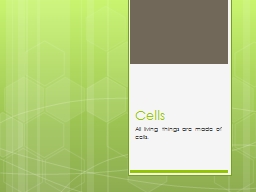

Overview Cells are the basic units of structure and function in living things What does cell structure mean What it is made of and how its parts are put together What does cell function mean ID: 1044519
Download Presentation The PPT/PDF document "Cells All living things are made of cell..." is the property of its rightful owner. Permission is granted to download and print the materials on this web site for personal, non-commercial use only, and to display it on your personal computer provided you do not modify the materials and that you retain all copyright notices contained in the materials. By downloading content from our website, you accept the terms of this agreement.
1. CellsAll living things are made of cells.
2. OverviewCells are the basic units of structure and function in living things. What does cell structure mean? What it is made of and how its parts are put together.What does cell function mean? the processes that enable it to stay alive and reproduce.What are some examples of cell function? Obtaining oxygen, getting rid of waste, obtaining food, and growing
3. The First Observation of CellsA microscope is an invention that makes smaller objects look larger.Robert Hooke was an English scientist and inventor and the first person to observe a cell.What did Hooke observe? CorkWho is Anton van Leeuwenhoek and what did he view in a microscope? A Dutch businessman and he observed lake water, scrapings from teeth and gums, and water from rain gutters. He was also the first to view single celled organisms.
4. Cell TheoryWho are the three German Scientists who developed Cell Theory? Schleiden, Schwann, and Virchow.Cell Theory states:All living things are composed of cells.Cells are the basic unit of structure and function in living things.All cells are produced from other cells.
5. MicroscopesLight microscopes and electron microscopes are two kinds of microscope scientists use today.What are the two important properties of microscopes? magnification and resolutionMagnification is the ability to make things look larger.The lenses in light microscopes magnifies an object by bending the light that passes through them.In a compound microscope, light passes through a specimen and then through two lenses. The first lens magnifies the object, and the second, magnifies it even more.
6. Microscopes Cont.The ability to clearly distinguish the individual part of an object is called resolution.Resolution is another term for sharpness of an image.Electron microscopes use a beam of electrons instead of light to produce a magnified image. Electron microscopes can obtain pictures of extremely small objects, objects much smaller than what can be seen with light microscopes.
7. Looking inside the CellOrganelles are structures with in the cell that carry out specific functions. The cell wall is a rigid layer of nonliving material that surrounds the cells of plants and some other organisms. The purpose of the cell wall is to protect and support the cell. It is made of cellulose and allows water and oxygen to easily pass through.
8. Continuing through the CellAll cells have a cell membrane. This controls what substances come into and out of the cell. It allows harmful waste products to leave the cell and prevents harmful material from entering.The “control center” of the cell is the nucleus. It acts as the brain, controlling all activity.The Nuclear envelope protects the nucleus.Chromatin are thin strands containing genetic material that give instructions for directing the cell’s function. The nucleolus is within the nucleus and here is where ribosomes (organelles where proteins are produced) are made.
9. Organelles in CytoplasmCytoplasm is the region between the cell membrane and the nucleus.What is the “powerhouses” of the cell?mitochondria Why are mitochondria known as the “powerhouses” of the cell? they convert energy in food molecules to energy the cell can use to carry out functions.Endoplasmic reticulum are like of maze of passage ways that carry proteins and other material from one part of the cell to another.Ribosomes are grainlike bodies attached to the surfaces of some endoplasmic reticulum. What is function of ribosomes? They are factories to produce proteins.
10. More Organelles in CytoplasmGolgi bodies look like flattened sacs and tubes. The Golgi body can be thought of as a mail room. They receive proteins, package them, and then distribute them to other parts of the cell.Chloroplasts are only found in plant cells. Chloroplasts capture energy from the sunlight and use it to produce food for the cell.A vacuole is a water filled sac used as a storage area for cells.The cell’s clean up crew are the lysosome. They are small, round structures containing chemicals that break down certain materials in the cell.
11. Special CellsA tissue is a group of similar cells that work together to perform a special function. Tissues form organs and organs form organ systems. Example BrainBacterial cells are very different from plant and animal cells. They are much smaller, have no nucleus, contain genetic material in the cytoplasm, and have ribosomes, but none of the other organelles found in plant or animal cells.